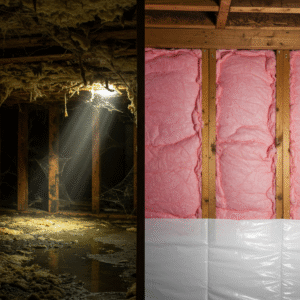Signs Your Crawl Space Needs Insulation
 If you’re wondering whether your crawl space is silently undermining your home’s comfort and efficiency, keep an eye (and nose) out for these common indicators. These aren’t just minor inconveniences; they’re your home’s way of telling you its foundation is compromised:
If you’re wondering whether your crawl space is silently undermining your home’s comfort and efficiency, keep an eye (and nose) out for these common indicators. These aren’t just minor inconveniences; they’re your home’s way of telling you its foundation is compromised:
Cold, Drafty Floors: This is often the most immediate and noticeable sign. If your bare feet feel perpetually chilled on your floors during winter, even with the thermostat cranked up, it’s highly likely that cold air from an uninsulated crawl space is seeping directly into your living areas.
Persistent Musty Odors: That damp, earthy, or “old house” smell isn’t just an aesthetic issue. It’s a strong indicator of excessive moisture, potential mold, mildew, or even pest activity in your crawl space. These unpleasant odors can easily migrate upwards into your home’s air.
Skyrocketing Energy Bills: Are your heating and cooling costs inexplicably high, despite your best efforts to conserve energy? An uninsulated crawl space allows conditioned air to escape and outside air to infiltrate, forcing your HVAC system to work overtime, year-round.
Excessive Indoor Humidity: During warmer months, if your home feels perpetually sticky, muggy, or you notice condensation on windows, pipes, or other surfaces, your crawl space might be allowing humid outdoor air to enter and circulate throughout your house.
Pest Infestations: Crawl spaces with moisture issues and easy entry points are a veritable haven for pests like rodents, insects (cockroaches, termites), and even snakes. If you’re seeing more unwelcome visitors inside, your crawl space could be the gateway.
Uneven Temperatures & Drafts: Do certain rooms feel significantly colder or hotter than others? Do you feel inexplicable drafts even when windows and doors are closed? Air leakage from an unsealed crawl space can create these frustrating hot and cold spots throughout your home.
Visible Mold or Mildew: If you dare to peek into your crawl space and spot any fuzzy, discolored growth on wooden joists, subflooring, insulation, or foundation walls, that’s a definitive sign of excessive moisture and a clear call for immediate intervention.
Sagging Floors or Structural Concerns: While a more severe and long-term consequence, persistent moisture in a crawl space can lead to wood rot in the structural components (joists, subflooring). If your floors feel bouncy, uneven, or appear to be sagging, it’s crucial to investigate the crawl space for structural damage.